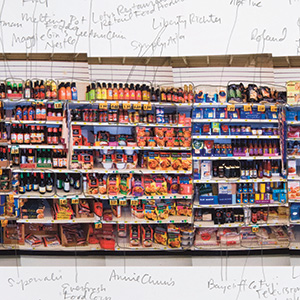Features & Columns
'Around the Table' at the
San Jose Museum of Art
 FOOD CHAIN: Rosemary Williams painstakingly researched the contents of grocery store shelves and her large-scale image 'Supermarket' reveals the small group of corporations that produce the bulk of grocery items.
FOOD CHAIN: Rosemary Williams painstakingly researched the contents of grocery store shelves and her large-scale image 'Supermarket' reveals the small group of corporations that produce the bulk of grocery items.
From chemical labs to kitchen refuse, via pigs' heads and curried wallpaper, a bouillabaisse of artistic creation has emerged at the San Jose Museum of Art's new exhibit: "Around the Table: food, creativity and community."
Through the work of 26 contemporary artists, 17 of them commissioned just for this exhibit, the museum has clarified all the ingredients into a fine consomme, creatively addressing the role food plays in our lives. You don't even need the taste buds of an art scholar to digest it all.
For example, artist Phil Ross is also a bioengineer and former chef. He knows how to make strong, durable binding agents from fungal tissue. Since we live in a world of depleted resources and building materials, Ross constructs working furniture prototypes from mushrooms he grows himself. In the gallery, one sees two chairs and two tables resulting from a collaboration with the Workshop Residence in San Francisco. Ross used local agricultural waste as the food for the fungal tissue and salvaged wood for the legs.
Across nearly one entire wall, Rosemary Williams' Supermarket (2008) is a 25-foot-long panoramic image of a typical supermarket aisle, annotated by her to identify the handful of corporations that own the majority of what's on the shelf. She meticulously researched and documented hundreds of items in the photo, revealing the degree to which ruthless conglomerates have monopolized the grocery industry.
There's even garbage on display. Sweet Corruptions (2010-2012) by New York artist Emilie Clark is an installation of her family's food waste over a four-month period, accompanied by drawings and paintings. We get to see actual food compost and garbage, preserved in latex, on a lab table of sorts. On the wall next to the foodstuffs, we see vibrant abstract watercolors of the food waste preservation process. The result is an exploration of just how much food humans actually toss away on a regular basis. We see that, as food decomposes, it begins a new life, both as a specimen to be observed and as a muse of creativity. It makes me want to start working in watercolor.
These particular food cycles of birth, life and death emerge throughout the exhibit. In the next room, for example, one finds the pesticide wallpaper of Kirsten Stolle and the pigs' heads of Pablo Cristi. In Stolle's case, she recooked several Monsanto ads from the '50s, glorifying evocative chemicals and their miracle uses in the food cycle, but then altered the texts to imply the opposite of what the ads actually said. Stolle also contributed an installation of '50s-era kitsch wallpaper, titled Miracle Grow, patterned with ads for chemicals popular in that era. She surrounded the ads with whimsical blue and pink motifs, typical of the period, to form a delicious ridicule of the pesticide industry.
Christi's work, Hipster Pig (2012), a title with multiple layers of meaning, is a righteous attack on the culture of hipster douchebags who appropriate the clothing and artifacts of working class families. We see the heads of pigs, constructed of flannel and denim, and painted with metallic automobile colors, as a reference to douchebags and gangbangers pirating those looks for their own fashion movements. On another level, it's a brilliant lampoon of hipster chefs who embody the "nose-to-tail" culture, which is nothing but a douchebag appropriation of how working class families, all over the world, for generations, have already been eating all parts of the pig.
Speaking of delicacies, the museum commissioned Sita Kuratomi Bhaumik to create a site-specific installation of wallpaper made from curry powder. One can smell the aroma when approaching. The artist often uses spices in her installations, but curry was her first, primarily due to her discovering racist comments online about Indian people and Indian food. Through this work, she provides a commentary on the relationship between food and racial stereotypes.
In the show, there's much more to chew on—jailhouse ramen recipes, ethnic takeout bags and war gastronomy, to rattle off but a few. I recommend the entire bouillabaisse. In fact, I'm getting hungry already.


